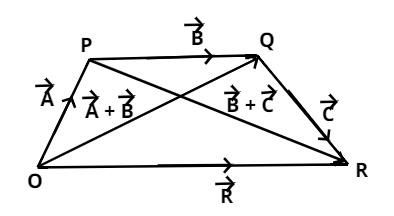
Write the associative law of addition of vectors.
Answer
606.9k+ views
Hint: Let us prove the associative law of addition of vectors by using a parallelogram with its sides as different vectors.
Complete step-by-step answer:

Now as we know that the associative law of addition of vectors states that the sum of the vectors remains same irrespective of their order or grouping in which they are arranged.
Like if \[\overrightarrow {\text{X}} \], \[\overrightarrow {\text{Y}} \] and \[\overrightarrow {\text{Z}} \] are the three vectors then according to associative law of addition of vectors \[\left( {\overrightarrow {\text{X}} {\text{ + }}\overrightarrow {\text{Y}} } \right){\text{ + }}\overrightarrow {\text{Z}} {\text{ = }}\overrightarrow {\text{X}} {\text{ + }}\left( {\overrightarrow {\text{Y}} {\text{ + }}\overrightarrow {\text{Z}} } \right)\]
As we know that according to head to tail rule if the head of one vector joins with the tail of another vector then the sum of both vectors will be the vector formed by the joining tail of one vector with the head of another.
So, now let \[\overrightarrow {\text{A}} \], \[\overrightarrow {\text{B}} \] and \[\overrightarrow {\text{C}} \] are the three vectors then applying head to tail rule to obtain the resultant of \[\overrightarrow {\text{A}} {\text{ + }}\overrightarrow {\text{B}} \] and \[\overrightarrow {\text{B}} {\text{ + }}\overrightarrow {\text{C}} \]
So, \[\overrightarrow {\text{A}} {\text{ + }}\overrightarrow {\text{B}} \] = \[\overrightarrow {{\text{OQ}}} \]
And, \[\overrightarrow {\text{B}} {\text{ + }}\overrightarrow {\text{C}} \] = \[\overrightarrow {{\text{PR}}} \]
Then finally again find the resultant of these three vectors,
So, \[\overrightarrow {{\text{OR}}} {\text{ = }}\overrightarrow {{\text{OP}}} {\text{ + }}\overrightarrow {{\text{PR}}} \]
Applying head to tail rule,
\[\overrightarrow {\text{R}} {\text{ = }}\overrightarrow {\text{A}} {\text{ + }}\left( {\overrightarrow {\text{B}} {\text{ + }}\overrightarrow {\text{C}} } \right)\] (1)
And, \[\overrightarrow {{\text{OR}}} {\text{ = }}\overrightarrow {{\text{OQ}}} {\text{ + }}\overrightarrow {{\text{QR}}} \]
Applying head to tail rule,
\[\overrightarrow {\text{R}} {\text{ = }}\left( {\overrightarrow {\text{A}} {\text{ + }}\overrightarrow {\text{B}} } \right){\text{ + }}\overrightarrow {\text{C}} {\text{ }}\] (2)
Thus, using equation 1 and 2. We can say that,
\[\left( {\overrightarrow {\text{A}} {\text{ + }}\overrightarrow {\text{B}} } \right){\text{ + }}\overrightarrow {\text{C}} {\text{ = }}\overrightarrow {\text{A}} {\text{ + }}\left( {\overrightarrow {\text{B}} {\text{ + }}\overrightarrow {\text{C}} } \right)\]
Hence, this fact is known as Associative law of vector addition.
Note: Whenever we come up with this type of problem then first, we assume that the three vectors as the sides of a parallelogram and then apply head to tail rule to find the sum of the vectors and this will prove the required result. And this will be the easiest and efficient way to prove the result.
Complete step-by-step answer:

Now as we know that the associative law of addition of vectors states that the sum of the vectors remains same irrespective of their order or grouping in which they are arranged.
Like if \[\overrightarrow {\text{X}} \], \[\overrightarrow {\text{Y}} \] and \[\overrightarrow {\text{Z}} \] are the three vectors then according to associative law of addition of vectors \[\left( {\overrightarrow {\text{X}} {\text{ + }}\overrightarrow {\text{Y}} } \right){\text{ + }}\overrightarrow {\text{Z}} {\text{ = }}\overrightarrow {\text{X}} {\text{ + }}\left( {\overrightarrow {\text{Y}} {\text{ + }}\overrightarrow {\text{Z}} } \right)\]
As we know that according to head to tail rule if the head of one vector joins with the tail of another vector then the sum of both vectors will be the vector formed by the joining tail of one vector with the head of another.
So, now let \[\overrightarrow {\text{A}} \], \[\overrightarrow {\text{B}} \] and \[\overrightarrow {\text{C}} \] are the three vectors then applying head to tail rule to obtain the resultant of \[\overrightarrow {\text{A}} {\text{ + }}\overrightarrow {\text{B}} \] and \[\overrightarrow {\text{B}} {\text{ + }}\overrightarrow {\text{C}} \]
So, \[\overrightarrow {\text{A}} {\text{ + }}\overrightarrow {\text{B}} \] = \[\overrightarrow {{\text{OQ}}} \]
And, \[\overrightarrow {\text{B}} {\text{ + }}\overrightarrow {\text{C}} \] = \[\overrightarrow {{\text{PR}}} \]
Then finally again find the resultant of these three vectors,
So, \[\overrightarrow {{\text{OR}}} {\text{ = }}\overrightarrow {{\text{OP}}} {\text{ + }}\overrightarrow {{\text{PR}}} \]
Applying head to tail rule,
\[\overrightarrow {\text{R}} {\text{ = }}\overrightarrow {\text{A}} {\text{ + }}\left( {\overrightarrow {\text{B}} {\text{ + }}\overrightarrow {\text{C}} } \right)\] (1)
And, \[\overrightarrow {{\text{OR}}} {\text{ = }}\overrightarrow {{\text{OQ}}} {\text{ + }}\overrightarrow {{\text{QR}}} \]
Applying head to tail rule,
\[\overrightarrow {\text{R}} {\text{ = }}\left( {\overrightarrow {\text{A}} {\text{ + }}\overrightarrow {\text{B}} } \right){\text{ + }}\overrightarrow {\text{C}} {\text{ }}\] (2)
Thus, using equation 1 and 2. We can say that,
\[\left( {\overrightarrow {\text{A}} {\text{ + }}\overrightarrow {\text{B}} } \right){\text{ + }}\overrightarrow {\text{C}} {\text{ = }}\overrightarrow {\text{A}} {\text{ + }}\left( {\overrightarrow {\text{B}} {\text{ + }}\overrightarrow {\text{C}} } \right)\]
Hence, this fact is known as Associative law of vector addition.
Note: Whenever we come up with this type of problem then first, we assume that the three vectors as the sides of a parallelogram and then apply head to tail rule to find the sum of the vectors and this will prove the required result. And this will be the easiest and efficient way to prove the result.
Recently Updated Pages
A man running at a speed 5 ms is viewed in the side class 12 physics CBSE

The number of solutions in x in 02pi for which sqrt class 12 maths CBSE

State and explain Hardy Weinbergs Principle class 12 biology CBSE

Write any two methods of preparation of phenol Give class 12 chemistry CBSE

Which of the following statements is wrong a Amnion class 12 biology CBSE

Differentiate between action potential and resting class 12 biology CBSE

Trending doubts
What are the major means of transport Explain each class 12 social science CBSE

Which are the Top 10 Largest Countries of the World?

Draw a labelled sketch of the human eye class 12 physics CBSE

Explain sex determination in humans with line diag class 12 biology CBSE

Explain sex determination in humans with the help of class 12 biology CBSE

Differentiate between homogeneous and heterogeneous class 12 chemistry CBSE




